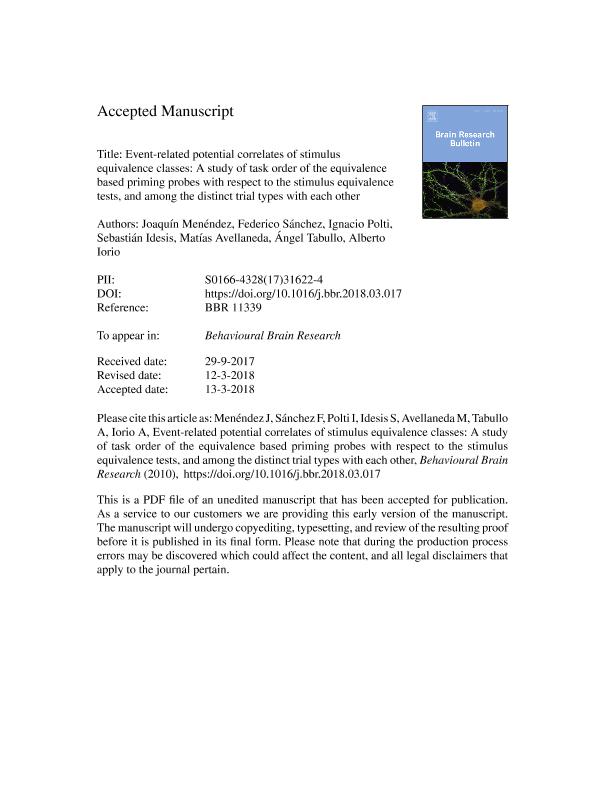Mostrar el registro sencillo del ítem
dc.contributor.author
Menendez, Joaquin

dc.contributor.author
Haro Sanchez, Federico Miguel

dc.contributor.author
Polti, Ignacio
dc.contributor.author
Idesis, Sebastián
dc.contributor.author
Avellaneda, Matías Alejandro

dc.contributor.author
Tabullo, Angel Javier

dc.contributor.author
Iorio, Alberto Andres

dc.date.available
2019-11-11T19:13:04Z
dc.date.issued
2018-07
dc.identifier.citation
Menendez, Joaquin; Haro Sanchez, Federico Miguel; Polti, Ignacio; Idesis, Sebastián; Avellaneda, Matías Alejandro; et al.; Event-related potential correlates of stimulus equivalence classes: A study of task order of the equivalence based priming probes with respect to the stimulus equivalence tests, and among the distinct trial types with each other; Elsevier Science; Behavioural Brain Research; 347; 7-2018; 242-254
dc.identifier.issn
0166-4328
dc.identifier.uri
http://hdl.handle.net/11336/88526
dc.description.abstract
This study investigates the influences of: 1) the task order of two stimulus equivalence classes (SEC) probes, and 2) the possible differences within the equivalence trial types. These factors were analyzed together on both behavioral and event-related potentials (ERP) data. Two groups of normal subjects participated in two successive sessions. In the first session, all participants were trained in the baseline relations among visual stimuli (pseudo-words). In the second session, one group performed the matching-to-sample (MTS) equivalence tests before the equivalence-relatedness-priming (EBRP) task, while the other group performed both tasks in reverse order. In the EBRP task related trial types included trained, symmetrical and equivalence relationships while the unrelated trial types included the same stimuli but without relationships. Event related potentials were recorded separately for related and unrelated conditions during the EBRP task. Results showed that response times to related trials were shorter than those to unrelated ones. At the electrophysiological level, two late waveforms were sensitive to the differences among the stimulus pairs of the EBRP task: Both waveforms were larger for the unrelated than the related conditions. Conversely, there were no main influences of the task order or of the trial types with each other. These results provide evidence that 1) the EBRP task exhibits priming effects among the SEC stimuli, 2) the behavioral and electrophysiological effects were similar regardless of whether the EBRP task was done before or after the MTS tests, and 3) there were no differences within the baseline and derived trial types in the EBRP task.
dc.format
application/pdf
dc.language.iso
eng
dc.publisher
Elsevier Science

dc.rights
info:eu-repo/semantics/openAccess
dc.rights.uri
https://creativecommons.org/licenses/by-nc-nd/2.5/ar/
dc.subject
EVENT-RELATED POTENTIALS
dc.subject
MATCHING TO SAMPLE
dc.subject
PRIMING EFFECTS
dc.subject
SEMANTIC PROCESSES
dc.subject
STIMULUS EQUIVALENCE
dc.subject.classification
Otras Ciencias Médicas

dc.subject.classification
Otras Ciencias Médicas

dc.subject.classification
CIENCIAS MÉDICAS Y DE LA SALUD

dc.title
Event-related potential correlates of stimulus equivalence classes: A study of task order of the equivalence based priming probes with respect to the stimulus equivalence tests, and among the distinct trial types with each other
dc.type
info:eu-repo/semantics/article
dc.type
info:ar-repo/semantics/artículo
dc.type
info:eu-repo/semantics/publishedVersion
dc.date.updated
2019-10-22T13:40:10Z
dc.journal.volume
347
dc.journal.pagination
242-254
dc.journal.pais
Países Bajos

dc.journal.ciudad
Amsterdam
dc.description.fil
Fil: Menendez, Joaquin. Universidad de Buenos Aires. Facultad de Psicología; Argentina. Consejo Nacional de Investigaciones Científicas y Técnicas. Instituto de Biología y Medicina Experimental. Fundación de Instituto de Biología y Medicina Experimental. Instituto de Biología y Medicina Experimental; Argentina
dc.description.fil
Fil: Haro Sanchez, Federico Miguel. Universidad de Buenos Aires. Facultad de Psicología; Argentina. Consejo Nacional de Investigaciones Científicas y Técnicas. Instituto de Biología y Medicina Experimental. Fundación de Instituto de Biología y Medicina Experimental. Instituto de Biología y Medicina Experimental; Argentina
dc.description.fil
Fil: Polti, Ignacio. Universidad de Buenos Aires. Facultad de Psicología; Argentina
dc.description.fil
Fil: Idesis, Sebastián. Universidad de Buenos Aires. Facultad de Psicología; Argentina
dc.description.fil
Fil: Avellaneda, Matías Alejandro. Universidad de Buenos Aires. Facultad de Psicología; Argentina. Consejo Nacional de Investigaciones Científicas y Técnicas; Argentina
dc.description.fil
Fil: Tabullo, Angel Javier. Consejo Nacional de Investigaciones Científicas y Técnicas. Centro Científico Tecnológico Conicet - Mendoza. Instituto de Ciencias Humanas, Sociales y Ambientales; Argentina
dc.description.fil
Fil: Iorio, Alberto Andres. Universidad de Buenos Aires. Facultad de Psicología; Argentina. Consejo Nacional de Investigaciones Científicas y Técnicas. Instituto de Biología y Medicina Experimental. Fundación de Instituto de Biología y Medicina Experimental. Instituto de Biología y Medicina Experimental; Argentina
dc.journal.title
Behavioural Brain Research

dc.relation.alternativeid
info:eu-repo/semantics/altIdentifier/url/https://www.sciencedirect.com/science/article/pii/S0166432817316224
dc.relation.alternativeid
info:eu-repo/semantics/altIdentifier/doi/https://doi.org/10.1016/j.bbr.2018.03.017
Archivos asociados
